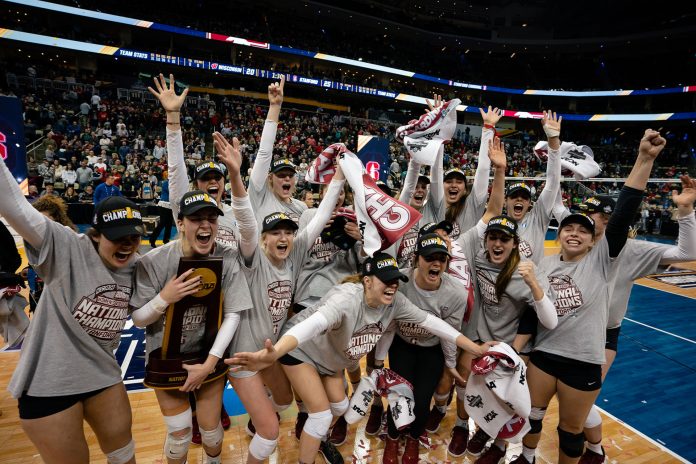Ignatius L Hoops
Well-known member
- Joined
- Sep 9, 2015
- Messages
- 10,928
- Reaction score
- 3,768
- Points
- 113

NCAA volleyball goes topsy-turvy: Oregon, UW join B1G; Arizona, ASU, Utah to Big 12 - Volleyballmag.com
If you’ve ever heard the legendary Bill Walton on Pac-12 basketball broadcasts, you’ve heard him tout the league as “the conference of champions.” Well, the Pac-12 has one more chance to win a championship in volleyball, because after the 2023-24 season the conference will be no more. Certainly...
Article includes quotes from Keegan Cook, John Cook and Kelly Sheffield
It started with Colorado.
After months of speculation, Colorado left the Pac-12 for its old league, the Big 12, on July 27. The momentum for more moves increased as Big Ten presidents approved commissioner Tony Petitti to engage with the two schools in the Pacific Northwest on Thursday.
Events moved quickly on Friday. It started with a reported failed grant-of-rights vote in the morning by the remaining nine schools in the Pac-12. Then by the afternoon, the Big Ten extended membership offers, followed by press releases announcing Oregon and Washington as new members.
We have links from all the schools below.
The Big Ten will now be a coast-to-coast conference, stretching from Seattle to Los Angeles to Washington, D.C., and the New York City metro area (Rutgers). While football (and its television contracts) is the main driving factor to conference realignment, the move continues to elevate the nation’s top volleyball conference.
Washington is one of just 12 schools that has won an NCAA volleyball championship with its 2005 title. The Huskies have played in five NCAA national semifinals in the past 20 years, including two years ago when Keegan Cook was the coach. He is now the new coach at Minnesota.

Oregon, which lost to Texas in the 2012 NCAA championship match, made the regional final last season before falling to Louisville.
With the addition of UCLA (4 titles), USC (3) and Washington (1) next year, Big Ten schools will have won 21 of the 42 NCAA championships. (Penn State 7, Nebraska 5, Wisconsin 1).
According to a Wikipedia listing, “Pac-12 members have won 553 NCAA national championships, which is 254 more than the next closest conference, the Big Ten.”
“I know B1G wrestling is a big deal, but this makes B1G volleyball … gnarly!” Maryland coach Adam Hughes Tweeted.
Wisconsin coach Kelly Sheffield said he’s eager for the new challenges. He said he learned a while ago that he has to accept and roll with new conference teams and other rule changes like NIL and transfers.
“For me, it’s mostly excitement for change,” he said. “I don’t want to be one of these old curmudgeons that are just reliving the glory days or the way that it used to be. Things are changing and get on board and let’s go.”
The big question is what happens to Stanford, winner of nine national championships, and Cal, Oregon State and Washington State. Those schools all put out statements saying they were examining their options.
In essence, there will be four major conferences. Previously the SEC added Texas and Oklahoma, the Big 12 previously added BYU, Cincinnati, Houston and UCF, and the ACC has stood pat.
“While I’m very happy to be joining and competing against the excellent volleyball programs in the Big 12, there is a mourning period that needs to happen for what the storied Pac-12 conference has been for over 100 years,” said Utah coach Beth Launiere, the longest-tenured coach at any of the major-conference schools as she starts here 34th season in Salt Lake City.
“It’s a somber feeling that needs time to digest. When that is finished, we will look forward to our next chapter as a program.”
Beginning with the 2024-25 academic year, the Big 12 will have 16 members: Arizona, Arizona State, Baylor, BYU, UCF, Cincinnati, Colorado, Houston, Iowa State, Kansas, Kansas State, Oklahoma State, TCU, Texas Tech, Utah and West Virginia. As Arizona State said in a news release, “Aligning with the University of Arizona and Utah was a key factor for ASU leadership. The moves will help create a strong Arizona-Utah-Texas portion of the conference that will extend current rivalries, create new ones, and offer regional travel for student-athletes.”
Could the remaining Pac-12 schools align with those in the Moutain West, West Coast Conference and/or Big West? Are Stanford and Cal a package deal?
The realignment hits Minnesota coach Cook on multiple levels. Until last December, he coached Washington for eight seasons before moving to the Gophers this offseason. His initial response was excitement about the additions.
“They’re tremendous institutions and amazing global programs,” Cook said. “It’s only great for the Big Ten, and I’m thrilled to be competing alongside them again.”
However, after reflecting more on the move, Cook said he had mixed emotions thinking about the players, coaches and administrators in the Pac-12 that helped grow the sport.
“I have just a lot of gratitude for the people and the history,” he said. “There’s a conference office full of people that I know and worked with who were great to me.”
How the Big Ten handles scheduling will be decided in the next 10 months. Currently, the league plays a 10-week, 20-match schedule where teams play seven teams in a home-and-home series and the other six league members once.
Sheffield said the new members could make the scheduling easier.
“I think if you’re playing everybody once you get to 17 (matches), I think that’s about as true of a championship,” he said.
Teams could play each opponent once for a 17-match schedule. To fill out the calendar, schools could play three regional teams a second time, a flexed game against a team in a similar spot in the standings of the league could add a conference tournament to cap off the regular season.
John Cook wasn’t in favor of a league tournament because of the timing of fitting it around Thanksgiving. He said from his discussions the Big Ten is moving away from using divisions a few years ago, but they might be inevitable now. He wouldn’t be against using an East-West divide and then having the top teams pay during the final week for a de facto championship.
One certainty is that travel will increase with at least one West Coast trip per team currently in the Big Ten. The new members could have a half dozen trips across multiple time zones.
“It’s a little unprecedented just in that I don’t know that anyone’s had to do those long trips week to week,” Keegan Cook said. “As someone who has taken 56 flights this year, I know it’s possible, but I’ve never been a Division I student-athlete. So what effect does that have on them? We’re going to find out pretty quickly, and I don’t expect them to be perfect in year one.
“I expect us to learn in year one, and the student-athletes will certainly have feedback on the experience if it’s not good for them.”
John Cook said the travel might be challenging, but teams are used to it. They fly all over the country during the early non-conference part of the schedule and manage it. For example, Nebraska has a one-off match at Stanford this season and usually makes an in-conference trip to the East Coast to play Rutgers and Maryland.
A limited schedule would heighten the importance of each regular-season match, especially between top teams. The new additions and scheduling format will make the path to a title more challenging.
With more teams in the league to schedule, some local rivalries might have to go to the wayside.
“The downside is there’s some of these schools that it’s just really, really fun to do a home-and-home,” Sheffield said. “We’ve got players that have come through here that have played eight regular-season matches against Minnesota or Nebraska. That’s kind of fun. I’d say that those days are probably about done.”
While conference realignment might not be finished, the Big Ten’s additions of Oregon and Washington changed the landscape and for volleyball and added two more powers to the league.
“I just think it’s great for the sport and great for TV,” John Cook said. “It’s just going to take us to another level — nationwide now. All these programs and their brands are going to be across the country. So I think it’s nothing but a positive for volleyball in that regard.”
